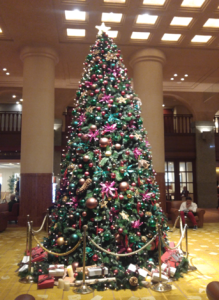Christmas tree and star of bethlehem
Yoshie Doi

Hotel Okura Kyoto lobby Photo taken on December 7, 2023
Christmas trees are decorated everywhere. Did you know that there is a star at the top of the Christmas tree? I didn’t notice it until recently. This was taught to me by the Kyo- Suzume staff.
When Jesus Christ was born in Bethlehem, a star like no one in the east had ever seen before appeared in the western sky. Stars were believed to represent the birth or fall of a person. The Magi (Melchior Balthazar and Caspar) learned from the star shining in the western sky that Jesus Christ, an old Jewish man, had been born, so they traveled in that direction.
As they walked down the road to Bethlehem, they looked down to the star that was guiding there and found Jesus in Mary’s arms.
A star is placed at the top of the Christmas tree to represent being guided by the star. This star is determined to be a pentagram (star-shaped pentagon). This is the most important decoration for the tree. This is because it is a symbol of the birth of Jesus Christ.
The British royal family released a photo of themselves surrounded by a Christmas tree at Windsor Castle in 18848. At that time, they decorated the top of the tree with an angel instead of a star. After that, it seems that not only stars but also angels began to be displayed. How do you like your Christmas tree? Just like in Japanese history, the boom starts from the royal family and the imperial family.
The history of Santa Claus is also interesting. The model is based on a real person who lived in present-day Turkey in the 4th century BC. The model is St. Nicholas, a saint who was revered as the “protector of children.” His parents died at a young age and he decided to use his parents’ inheritance in a way that was pleasing to God and continued to give gifts to the poor.
When Nicholas heard that the father of a poor family will have been selling his daughter was about to be sold, Nicholas secretly threw him a gold coin through the window at night. He was grateful that he was able to safely marry off his two daughters with that money. When St. Nicholas threw a gold coin for his third daughter, it landed in a sock that was drying next to the fireplace, making Nicholas cry out, “Ah!” His father sincerely thanked Nikolaus. Nicholas asked, “Please keep this a secret from everyone else.” It is said that from this legend people started putting Christmas presents in stockings.
There is also a theory that when daughter’s father did not accept gifts from Nicholas, Nicholas threw the gold coins down the chimney and it ended up in a sock that was left in the fireplace.
This legend of Nicholas was brought to New York from Europe, and the Dutch word “Santa Kiaas” (St. Claus) was accented in America and became “Santa Claus”.
In Japan, Meijiya in Ginza made headlines during the Meiji period (1900) when it decorated Christmas trees and illuminations. It became established as a non-religious event, with Japanese performances such as kagura performed at the Imperial Hotel. In 1909, Fujiya released a Christmas cake.
During the Taisho era, children’s magazines began featuring stories related to Christmas in their December issues, and events at Tokyo Disneyland and Universal Studios Japan led to the story becoming widely known around 2000.
I am not sure about the store that first sold Christmas cakes in Kyoto, but it is possible that Murakami Kaishindo, Kyoto’s oldest Western confectionery store, which was founded in 1900, sold them as Western confectioneries, but I couldn’t confirm for sure.
The end of document
Translated by Masami Otani
